| Look up Felixstowe in Wiktionary, the free dictionary. |
Felixstowe may refer to:
| Look up Felixstowe in Wiktionary, the free dictionary. |
Felixstowe may refer to:
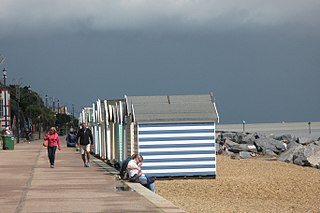
Felixstowe is a seaside town in Suffolk, England. At the 2011 Census, it had a population of 23,689. The Port of Felixstowe is the largest container port in the United Kingdom.

The Port of Felixstowe, in Felixstowe, Suffolk is the United Kingdom's busiest container port, dealing with 48% of Britain's containerised trade. In 2011, it was ranked as the 5th busiest container port in the world and Europe's busiest. The port handled 9.74 million twenty-foot equivalent units (TEU) of traffic in 2018.

Felixstowe Ferry is a hamlet in Suffolk, England, approximately two miles northeast of Felixstowe at the mouth of the River Deben with a ferry to the Bawdsey peninsula.

The Felixstowe F.2 was a 1917 British flying boat class designed and developed by Lieutenant Commander John Cyril Porte RN at the naval air station, Felixstowe during the First World War adapting a larger version of his superior Felixstowe F.1 hull design married with the larger Curtiss H-12 flying boat. The Felixstowe hull had superior water contacting attributes and became a key base technology in most seaplane designs thereafter.
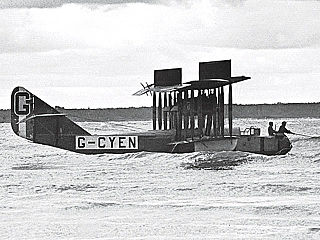
The Felixstowe F.3 was a British First World War flying boat, successor to the Felixstowe F.2 designed by Lieutenant Commander John Cyril Porte RN at the naval air station, Felixstowe.

The Felixstowe F.5 was a British First World War flying boat designed by Lieutenant Commander John Cyril Porte RN of the Seaplane Experimental Station, Felixstowe.
The Seaplane Experimental Station, formerly RNAS Felixstowe, was a British aircraft design unit during the early part of the 20th century.
HMS Felixstowe was a Bangor-class minesweepers built for the Royal Navy during the Second World War.
Felixstow is a suburb of Adelaide, situated in the City of Norwood Payneham St Peters.
| This disambiguation page lists articles associated with the title Felixstowe. If an internal link led you here, you may wish to change the link to point directly to the intended article. |
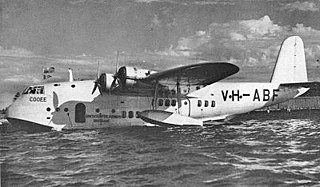
A flying boat is a fixed-winged seaplane with a hull, allowing it to land on water, that usually has no type of landing gear to allow operation on land. It differs from a floatplane as it uses a purpose-designed fuselage which can float, granting the aircraft buoyancy. Flying boats may be stabilized by under-wing floats or by wing-like projections from the fuselage. Flying boats were some of the largest aircraft of the first half of the 20th century, exceeded in size only by bombers developed during World War II. Their advantage lay in using water instead of expensive land-based runways, making them the basis for international airlines in the interwar period. They were also commonly used for maritime patrol and air-sea rescue.
A parasite aircraft is a component of a composite aircraft which is carried aloft and air launched by a larger carrier aircraft or mother ship to support the primary mission of the carrier. The carrier craft may or may not be able to later recover the parasite during flight.

The twin-engine F5L was one of the Felixstowe F series of flying boats developed by John Cyril Porte at the Seaplane Experimental Station, Felixstowe, England, during the First World War for production in America.

The Felixstowe Porte Baby was a British reconnaissance flying boat of the First World War, first flying in 1915.

Lieutenant Colonel John Cyril Porte, was a British flying boat pioneer associated with the World War I Seaplane Experimental Station at Felixstowe.
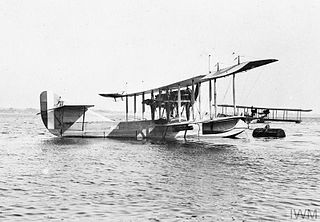
The Curtiss Model H was a family of classes of early long-range flying boats, the first two of which were developed directly on commission in the United States in response to the ₤10,000 prize challenge issued in 1913 by the London newspaper, the Daily Mail, for the first non-stop aerial crossing of the Atlantic. As the first aircraft having transatlantic range and cargo-carrying capacity, it became the grandfather development leading to early international commercial air travel, and by extension, to the modern world of commercial aviation. The last widely produced class, the Model H-12, was retrospectively designated Model 6 by Curtiss' company in the 1930s, and various classes have variants with suffixed letters indicating differences.

The Norman Thompson N.T.4 was a twin-engined British flying boat of the First World War. Although less well known than similar Curtiss and Felixstowe flying boats, 50 were ordered for Britain's Royal Naval Air Service.
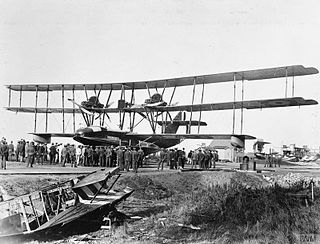
The Felixstowe F.4 Fury, also known as the Porte Super-Baby, was a large British, five-engined triplane flying-boat designed by John Cyril Porte at the Seaplane Experimental Station, Felixstowe, inspired by the Wanamaker Triplane/Curtiss Model T. At the time the Fury was the largest seaplane in the world, the largest British aircraft, and the first aircraft controlled successfully by servo-assisted means.

The Short N.3 Cromarty was a prototype British twin-engined biplane flying boat, designed towards the end of the First World War. Only a single example was built, which first flew in 1921 and was wrecked in 1922.

The Felixstowe F.1 was a British experimental flying boat designed and developed by Lieutenant Commander John Cyril Porte RN at the naval air station, Felixstowe based on the Curtiss H-4 with a new hull. Its design led to a range of successful larger flying boats that was assistance in promoting Britain as a leader in this field of aviation.

The Wanamaker Triplane or Curtiss Model T, retroactively renamed Curtiss Model 3 was a large experimental four-engined triplane patrol flying boat of World War I. It was the first four-engined aircraft built in the United States. Only a single example (No.3073) was completed. At the time, the Triplane was the largest seaplane in the world.

Royal Air Force Felixstowe or more simply RAF Felixstowe is a former Royal Air Force station located 2.7 miles (4.3 km) northeast of Harwich, Essex, England and 10.7 miles (17.2 km) southeast of Ipswich, Suffolk.
The Gosport Aircraft Company was a short-lived British aircraft manufacturer based at Gosport, Hampshire formed at the start of the First World War by Sir Charles Allom of White, Allom & Company and Charles Ernest Nicholson of Camper and Nicholsons boat-builders. The company built a number of flying-boats for the British government including the hull for the Fairey Atalanta which at the time was the largest flying-boat hull built in the world.

RAF Catfirth was a First World War Royal Naval Air Service (RNAS), and later Royal Air Force (RAF), seaplane base located on the island of Mainland in the Shetland Islands.